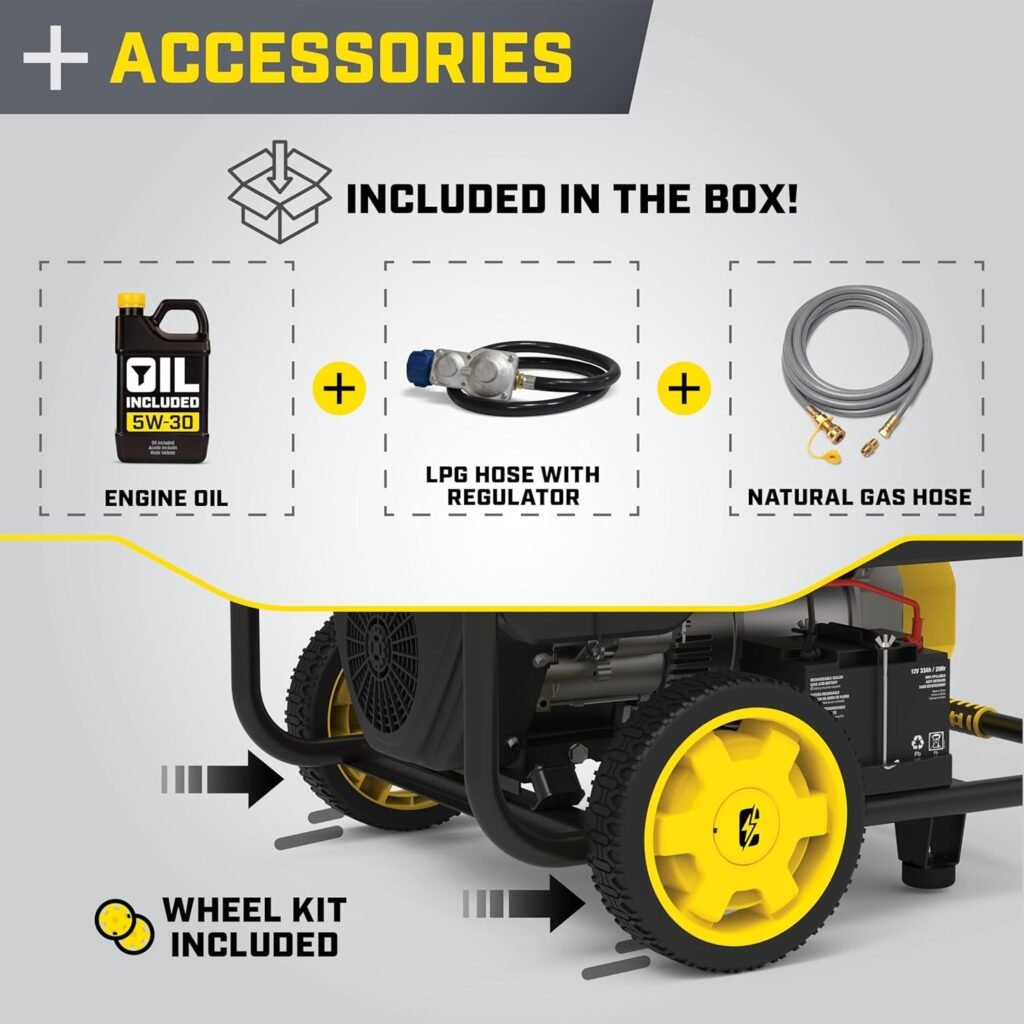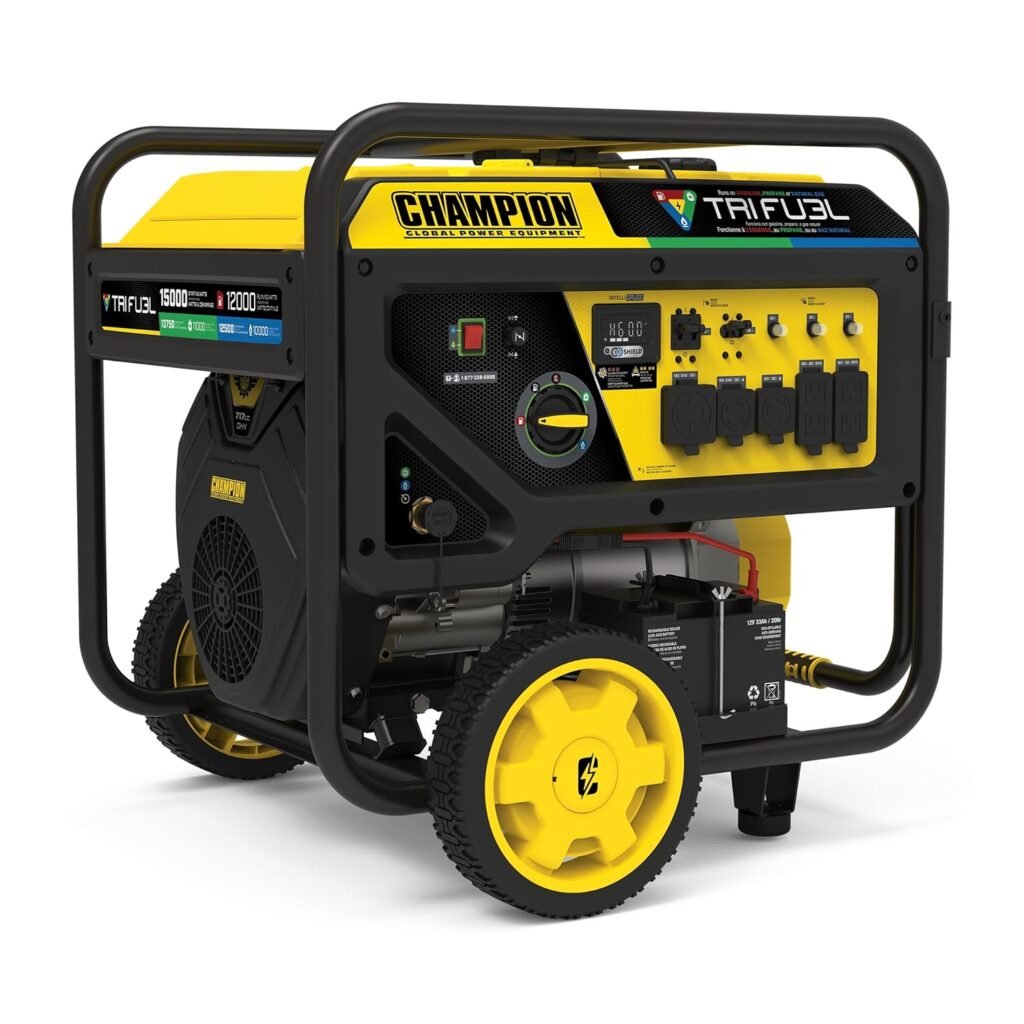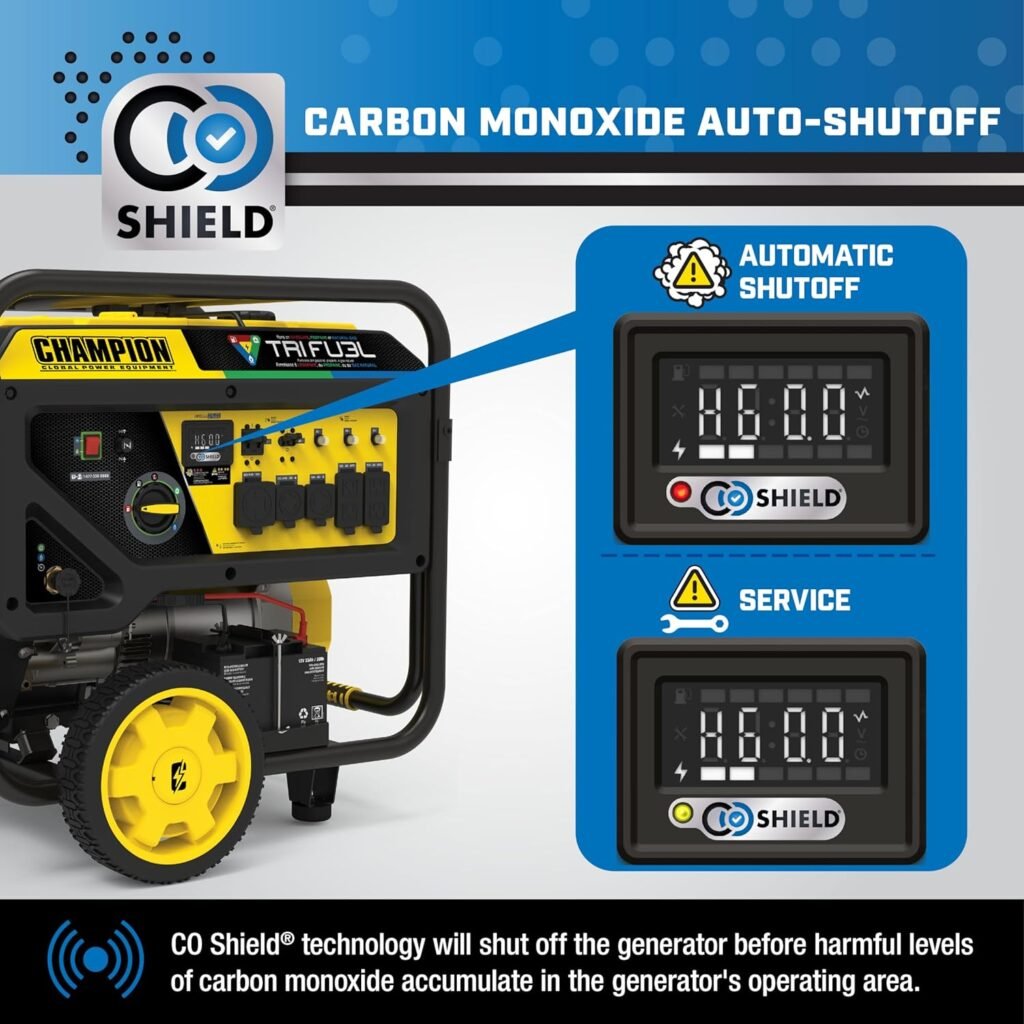
Are we ready to see whether the Champion Power Equipment 15,000-Watt Electric Start Tri Fuel Home Backup Portable Generator with CO Shield fits our home backup and job-site needs?
Overall Impression
We find this generator to be a compelling option for anyone who wants flexible fuel options, strong power output, and built-in safety features. Our first reaction is that Champion packed a lot of practical functionality into a single package, making this model useful for both emergency home backup and demanding portable power situations.
Key Specifications at a Glance
We like having the important numbers in one place to help with quick comparisons. Below is a compact breakdown of the most relevant specs so we can see what the unit promises before getting into details.
| Specification | Detail |
|---|---|
| Product Name | Champion Power Equipment 15,000-Watt Electric Start Tri Fuel Home Backup Portable Generator with CO Shield |
| Starting Watts | 15,000 watts |
| Running Watts | 12,000 watts |
| Engine | 717cc Milwaukee Series V-Twin |
| Start Type | Electric start (battery included) with toggle switch |
| Fuel Types | Gasoline, Propane, Natural Gas (tri-fuel) |
| Run Time | Up to 9 hours on a full tank of gasoline |
| Noise Level | 78 dBA @ 23 ft |
| Safety Feature | CO Shield carbon monoxide auto shutoff |
| Monitoring | Intelligauge (voltage, Hz, run-time hours) |
| Included | Natural gas and propane hoses |
| Warranty | 3-year limited warranty + FREE lifetime tech support |
What “Tri-Fuel” Actually Means for Us
We appreciate the flexibility offered by tri-fuel capability because it removes a lot of constraints during an outage or on remote sites. Being able to switch among gasoline, propane, and natural gas allows us to choose the most convenient or cost-effective fuel source available.
Fuel Hoses Included
We like that Champion includes both natural gas and propane hoses so the unit is ready to run on any of these fuel types straight out of the box. That saves us time and money compared with buying adapters or installing extra fittings.
Power Output and Capacity
We focus on both the peak starting watts and the continuous running watts because they determine which appliances and equipment we can safely power. With 15,000 starting watts and 12,000 running watts, this generator fits into the class that can handle several large household loads simultaneously.
What 12,000 Running Watts Allows Us to Power
We can run multiple heavy loads such as a refrigerator, freezer, furnace fan, sump pump, and some lights at the same time without overloading the generator. For most homes, 12,000 running watts covers critical circuits and a few comforts like microwave or window AC during an outage.
Starting Watts Importance
We remember that motor-driven appliances need extra power at startup, so the 15,000 starting watt rating matters for items like well pumps, HVAC compressors, and some power tools. The higher surge capacity reduces the risk of tripping breakers or stalling the generator when a motor starts.
Engine and Starting System
We appreciate the choice of a 717cc Milwaukee Series V-Twin engine because it signals a heavy-duty powerplant designed for prolonged use. The battery-included electric start with a simple toggle switch makes starting straightforward, especially during stressful power outages.
Reliability of the Milwaukee Series Engine
We expect the Milwaukee Series engine to deliver robust torque and consistent performance, which helps when powering high-load starts repeatedly. The larger displacement engine is beneficial when sustained loads and frequent motor starts are part of our use case.
Electric Start Convenience
We find battery starting much easier than pull starts, particularly for anyone who might struggle with manual recoil or during cold weather. Including the battery in the package removes another setup step and ensures the unit is ready to run from day one.
Run Time and Fuel Efficiency
We value knowing how long the generator will run on a tank so we can plan fuel needs during extended outages. Champion rates up to 9 hours of run time on a full tank of gasoline, which provides a reasonable window of continuous power for many overnight or day-long outages.
Factors Affecting Run Time
We keep in mind that actual run time will vary based on load, fuel type, and environmental conditions. Running at full rated load will shorten runtime compared to light or moderate loads, and propane or natural gas run times depend on the supply and pressure.
Refueling and Fuel Management
We recommend planning refueling intervals and having safe storage for gasoline or an accessible natural gas hookup when possible. Propane tanks can be swapped for extended use, and having a fuel strategy prevents unexpected outages during long events.
Noise Level and Site Considerations
We notice the 78 dBA noise rating at 23 feet, which is loud enough to be noticeable but within the expected range for a powerful open-frame portable generator. For residential neighborhoods, we should be aware of local noise ordinances and consider placement and possible muffling strategies if quiet operation is important.
Comparing Noise to Alternatives
We realize inverter-based or enclosure models are generally quieter, but they often come at higher cost and may not offer the same raw power. If we need heavy-duty capacity and tri-fuel flexibility, some noise is the trade-off we accept.
CO Shield Carbon Monoxide Auto Shutoff
We are reassured that the generator includes Champion’s CO Shield carbon monoxide auto shutoff system because safety around CO emissions is critical. This feature can automatically shut the engine off if dangerous CO levels are detected, reducing the risk of poisoning.
How CO Shield Changes Safe Operation
We still plan to follow safe placement guidelines—outdoors, clear of windows and vents—but having an automatic CO shutoff adds another layer of protection if conditions change or if the unit is accidentally placed too close to living areas. We consider CO Shield as a useful redundancy rather than a substitute for basic safety practices.
Controls, Monitoring, and the Intelligauge
We like that the unit includes an Intelligauge to keep track of voltage, hertz, and run-time hours because it helps us monitor output quality and schedule maintenance. Real-time monitoring is particularly useful when powering sensitive electronics or when balancing loads across circuits.
Practical Use of the Intelligauge
We use the Intelligauge to confirm stable output and to log run-time for oil changes and other service intervals. Having voltage and frequency readouts helps diagnose issues quickly, such as an unstable load or generator underperformance.
Outlet Selection and Load Management
We prioritize knowing what outlets are available so we can plan properly for transfer switches, RV connections, or direct plug-in devices. Although specific outlet counts and types vary by model version and region, we recommend checking the exact package to ensure compatibility with transfer panels and heavy-duty plugs.
Transfer Switch Integration
We advise using a proper manual or automatic transfer switch for whole-house connections rather than attempting to backfeed through household outlets. Transfer switches protect utility workers, prevent damage to the generator and home wiring, and allow safer switching between grid and generator power.
Portability and Handling
We appreciate features that make moving and loading the unit easier, especially given the weight and size typical of a model with a 717cc engine. Champion states that the generator is designed for safe and easy transport, loading, and unloading, which usually means integrated lifting points, solid wheel kits, or folding handles.
Setup and Placement Considerations
We suggest planning placement ahead of a storm or job, including a firm, level surface and adequate clearance for ventilation and exhaust. Good placement reduces the hassle when an outage hits and minimizes the risk of damage or poor airflow.
Build Quality and Durability
We find that Champion tends to produce rugged, utilitarian units built for function first, then form. For those expecting long-term use in demanding conditions, the robust engine and practical frame design typically hold up well with routine maintenance.
Expected Maintenance Needs
We anticipate standard maintenance items like oil and filter changes, spark plug service, air filter checks, and battery maintenance for the electric start. Scheduling these services by run-time hours tracked via the Intelligauge helps extend the unit’s lifespan and maintain performance.
Warranty and Technical Support
We value the included 3-year limited warranty and the promise of FREE lifetime technical support, which increases our confidence in the purchase. Knowing that expert support is available can simplify troubleshooting and reduce downtime during critical periods.
How to Use the Warranty and Support
We recommend registering the generator after purchase and keeping service records in case warranty service is needed. If we run into issues, accessing the manufacturer’s technical support can speed diagnosis and advise on parts or repair options.
Safety Checklist for Use
We like structured safety steps to prevent accidents and to comply with best practices. Below are essential checks we use before and during operation to keep ourselves and others safe.
- Position the generator outdoors, on level ground, away from doors, windows, and vents.
- Keep the unit clear of combustible materials and ensure proper ventilation around the engine and exhaust.
- Use grounded cords and proper RV or transfer-switch connections to avoid backfeed.
- Regularly monitor oil level, battery charge, and fuel connections, especially after long idle periods.
- Keep a CO detector installed in living areas as an additional safety measure even with CO Shield.
Common Use Cases We Recommend
We find that this generator is versatile enough to serve several primary roles depending on our needs and setup. Here are common scenarios where the Champion 15,000-Watt unit could be a strong match.
Home Backup for Critical Loads
We would configure the generator with a transfer switch to power critical circuits—heating or AC, refrigerator/freezer, sump pump, and a few outlets—ensuring that essential systems remain online during an outage. The unit’s wattage allows more flexibility than smaller portable generators, reducing the need to prioritize loads heavily.
Job Site or Tools
We see the unit as a solid choice for job sites where multiple heavy tools or air compressors might run concurrently. Electric start and tri-fuel capability can be especially helpful when gasoline availability is limited or when quieter, cleaner propane is preferred.
Recreational Use and RV
We can use propane or gasoline to run an RV’s air conditioner and appliances, though we recommend verifying outlet compatibility for the RV’s power inlet. The raw power makes it suitable for larger RVs or for situations where multiple amenities need to run at once.
Pros and Cons Summary
We like to summarize the main advantages and trade-offs so that decision-making is easier. This lightweight summary helps us weigh practical considerations against our specific requirements.
Pros:
- Tri-fuel flexibility with hoses included for natural gas and propane.
- High starting and running wattage suitable for many whole-house or heavy-duty needs.
- Reliable 717cc Milwaukee Series engine with battery electric start.
- CO Shield automatic shutoff for added safety.
- Intelligauge for real-time monitoring and maintenance tracking.
- 3-year limited warranty plus lifetime technical support.
Cons:
- Noise level (78 dBA at 23 ft) may be objectionable in quiet neighborhoods.
- Likely heavy and bulky; we should budget helpers or equipment for transport.
- Actual run time on propane or natural gas depends on supply setup and will vary.
- Requires correct transfer switch and professional installation for whole-house use.
Comparison to Similar Generators
We like to position a product relative to alternatives to see whether it stands out for price, features, or reliability. When compared to other high-capacity portable generators, the Champion model competes strongly on tri-fuel flexibility and safety features but may be outpaced by quieter inverter or enclosed models if noise is the primary concern.
Where It Outshines Competitors
We see real value in the inclusion of both hoses and the CO Shield system as standard features; not all competing models include these. The Milwaukee Series engine also gives us confidence in sustained performance compared with smaller-displacement engines.
Where Others Might Beat It
If we prioritize silent operation or ultra-lightweight portability, inverter-based or quieter enclosed models may be better despite lower raw wattage. Some brands offer longer warranties or telematics options for remote monitoring that the Champion model does not list.
Installation and Setup Tips
We recommend a few practical steps to make initial setup smooth and safe for first use. These tips help us reduce surprises and get reliable operation quickly.
- Read the manual fully before first start and follow the break-in procedures.
- Register the product to activate warranty benefits and access support.
- Install a proper transfer switch with a licensed electrician for whole-house integration.
- Test run the generator under load after installation to verify stable performance.
- Securely store the included hoses and any adapters in a labeled kit for emergency preparedness.
Troubleshooting Common Issues
We like to be prepared with basic troubleshooting knowledge to minimize downtime. Below are typical problems and easy checks we use before calling technical support.
- If the unit won’t start: confirm battery charge, fuel valve position, and choke setting.
- If the voltage is unstable: check load balance, tighten connections, and verify fuel supply.
- If the CO Shield triggers unexpectedly: move the generator to a more open area and check exhaust path for obstructions.
- If noise or unusual vibration appears: inspect engine mounts, muffler, and secured panels.
Maintenance Schedule Recommendations
We find a predictable maintenance routine keeps generators reliable when we need them most. Using the Intelligauge run-time hours helps us schedule service at appropriate intervals without guesswork.
- Every 8–20 hours or monthly: Check oil level and run the unit briefly under load.
- Every 50–100 hours: Change oil and inspect air filter and spark plugs.
- Annually or after 100 hours: Perform a full service including fuel system check, battery inspection, and valve clearance as recommended by the manual.
- Winter storage: Stabilize fuel or drain gasoline, disconnect battery, and store in a dry place.
Accessories and Add-Ons We Recommend
We often pair the generator with a few accessories that make operation cleaner, safer, and more convenient. Investing in the right extras reduces hassles during emergencies.
- Transfer switch and interlock kit installed by a professional electrician.
- Heavy-duty, properly rated extension cords and power inlet kits for RVs.
- Propane tank(s) or natural gas hookup if extended runtime is anticipated.
- Fuel stabilizer for stored gasoline and a battery maintainer for the starting battery.
- Wheel kit, lift assist, or dolly if not included or if mobility is a concern.
Pricing and Value Considerations
We weigh the price against features, warranty, and expected longevity to assess value. Given its wattage, tri-fuel capability, CO Shield, and included accessories, we feel the Champion 15,000-Watt model offers a strong value proposition for those needing robust, versatile portable power.
Long-Term Cost Factors
We also consider long-term costs such as fuel expenses, maintenance, and parts when judging overall value. Tri-fuel flexibility can reduce long-term fuel costs if we favor natural gas in our home or propane bulk purchases.
Buying Checklist
We like concise checklists to ensure we buy the right model and get setup right the first time. Before purchasing, confirm the following so we avoid surprises.
- Confirm that 12,000 running watts meets our actual load calculation.
- Check outlet types and counts to match our transfer switch or RV inlet.
- Verify included accessories (hoses, battery, wheel kit) to ensure readiness.
- Ensure we can meet local noise and placement regulations for generator operation.
- Plan for professional transfer switch installation if whole-house backup is desired.
Final Verdict
We find the Champion Power Equipment 15,000-Watt Electric Start Tri Fuel Home Backup Portable Generator with CO Shield to be a powerful, flexible, and thoughtfully equipped solution for homeowners and professionals alike. Our overall assessment is that it balances raw capacity, safety, and fuel versatility in a way that meets the needs of most serious portable power users while offering practical support through warranty and lifetime technical assistance.
Who Should Buy This Generator
We recommend this unit for homeowners who want robust whole-house backup capability, contractors who need dependable job-site power, and RV owners with large power requirements who value tri-fuel adaptability. If quiet operation or ultra-compact portability is a top priority, we might consider other models, but for raw performance and safety features, this Champion generator is a strong contender.
Final Practical Reminders
We remind ourselves to practice safe operation and periodic test runs to ensure readiness when outages occur. Keeping the manual, tools, fuel, and contact details for technical support handy helps us maintain the generator’s reliability and protect our investment.
Disclosure: As an Amazon Associate, I earn from qualifying purchases.




